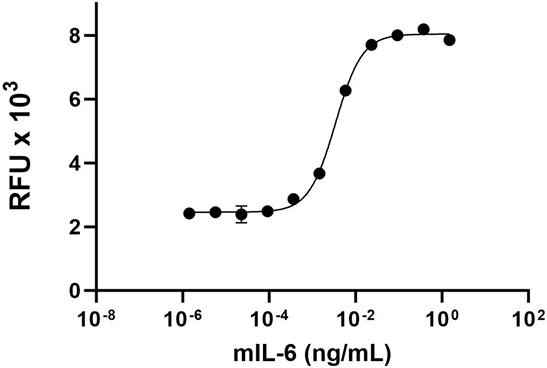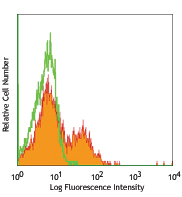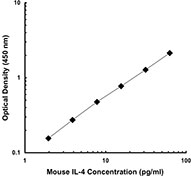- Regulatory Status
- RUO
- Other Names
- TGFB, DPD1, transforming growth factor, Transforming Growth Factor Beta 1, TGF-Beta-1
- Ave. Rating
- Submit a Review
- Product Citations
- publications

-

TGF-β1 inhibits the proliferation of mouse HT-2 cells induced by recombinant mouse IL-4 (Cat. No. 574302). The ED50 for this effect is 0.05 – 0.25 ng/mL. -

Stability Testing for Recombinant Human TGF-β1. Recombinant Human TGF-β1 was aliquoted in <30% Acetonitrile, 0.1% TFA (trifluoroacetic acid) at 0.2 mg/mL. One aliquot was frozen and thawed four times (4x Freeze/Thaws) and compared to the control that was kept at 4°C (Control). The samples were tested for their ability to inhibit the proliferation of mouse HT-2 cells induced by recombinant mouse IL-4 (Cat. No. 574302). The ED50 for this effect is 0.05 – 0.25 ng/mL.
| Cat # | Size | Price | Quantity Check Availability | Save | ||
|---|---|---|---|---|---|---|
| 781802 | 10 µg | 179€ | ||||
| 781804 | 25 µg | 352€ | ||||
TGF-β1 is synthesized in cells as a 390-amino acid. Furin cleaves the protein at residue 278, yielding an N-terminal cleavage product which corresponds to the latency-associated peptide (LAP), and the 25-kD C-terminal portion of the precursor constitutes the mature TGF-β1. TGF-β activators can release TGF-β from LAP. These activators include proteases that degrade LAP, thrombospondin-1, reactive oxygen species, and integrins avb6 and avb8. Mouse TGF-β converts naïve T cells into regulatory T (Treg) cells that prevent autoimmunity. Although human TGF-β1 is widely used for inducing FOXP3+ in vitro, it might not be an essential factor for human Treg differentiation. Th17 murine can be induced from naïve CD4+ T cells by the combination of TGF-β1 and IL-6 or IL-21. Nevertheless, the regulation of human Th17 differentiation is distinct. TGF-β1 seems to have dual effects on human Th17 differentiation in a dose-dependent manner. While TGF-β1 is required for the expression of RORγt, in human naive CD4+ T cells from cord blood, TGF-β1 can inhibit the function of RORγt at high doses. By using serum-free medium, it has been clarified that the optimum conditions for human Th17 differentiation are TGF-β1, IL-1β, and IL-2 in combination with IL-6, IL-21 or IL-23.
Product DetailsProduct Details
- Source
- Human TGF-β1, amino acid Ala279 –Ser390 (Accession # P01137) was expressed in CHO cells.
- Molecular Mass
- The 112 amino acid recombinant protein has a predicted molecular mass of approximately 12.7 kD. The DTT-reduced and non-reduced proteins migrate at approximately 14 kD and 28 kD respectively by SDS-PAGE. The predicted N-terminal amino acid is Ala.
- Purity
- >95%, as determined by Coomassie stained SDS-PAGE.
- Formulation
- 0.22 µm filtered protein solution is in 0.1% TFA, 10% Acetonitrile
- Endotoxin Level
- Less than 0.1 EU per µg protein as determined by the LAL method.
- Concentration
- 10 and 25 µg sizes are bottled at 200 µg/mL. 100 µg size and larger sizes are lot-specific and bottled at the concentration indicated on the vial. To obtain lot-specific concentration and expiration, please enter the lot number in our Certificate of Analysis online tool.
- Storage & Handling
- Unopened vial can be stored between 2°C and 8°C for up to 2 weeks, at -20°C for up to six months, or at -70°C or colder until the expiration date. For maximum results, quick spin vial prior to opening. The protein can be aliquoted and stored at -20°C or colder. Stock solutions can also be prepared at 50 - 100 µg/mL in appropriate sterile buffer, carrier protein such as 0.2 - 1% BSA or HSA can be added when preparing the stock solution. Aliquots can be stored between 2°C and 8°C for up to one week and stored at -20°C or colder for up to 3 months. Avoid repeated freeze/thaw cycles.
- Activity
- Human TGF-β1 inhibits the proliferation of mouse HT-2 cells induced by recombinant mouse IL-4 (Cat. No. 574302) The ED50 for this effect is 0.05 – 0.25 ng/mL.
- Application
-
Bioassay
- Application Notes
-
BioLegend carrier-free recombinant proteins provided in liquid format are shipped on blue ice. Our comparison testing data indicates that when handled and stored as recommended, the liquid format has equal or better stability and shelf-life compared to commercially available lyophilized proteins after reconstitution. Our liquid proteins are verified in-house to maintain activity after shipping on blue ice and are backed by our 100% satisfaction guarantee. If you have any concerns, contact us at tech@biolegend.com.
- Product Citations
-
Antigen Details
- Structure
- Dimer
- Distribution
-
TGF-β1 is secreted by numerous cells.
- Function
- TGF-β1 is a multifunctional cytokine that plays pivotal roles in diverse biological processes, including the regulation of cell growth and survival, cell and tissue differentiation, development, inflammation, immunity, hematopoiesis, and tissue remodeling and repair. TGF-β1 is essential for wound healing, stimulates matrix molecule deposition and angiogenesis, and is an essential mediator of the pathologic scarring in fibrotic disorders.
- Interaction
- TGF-beta binding protein (LTBP), epithelial cells, fibroblasts, T cells, B cells, macrophages, and multiple cells respond to TGF-β1.
- Ligand/Receptor
- TGF-β1 binds to type II and type I serine/threonine kinase receptors, which initiate intracellular signals through activation of Smad proteins.
- Cell Type
- Embryonic Stem Cells, Endothelial cells, Fibroblasts, Mesenchymal cells, Mesenchymal Stem Cells, Neural Stem Cells, Osteoclasts, Th17, Tregs
- Biology Area
- Cardiovascular Biology, Immuno-Oncology, Immunology, Stem Cells
- Molecular Family
- Cytokines/Chemokines
- Antigen References
-
- Sun X, et al. 2013. J Virol. 87:10126.
- Benlhabib H, et al. 2015. J Biol Chem. 290:22409-22422.
- Lin C, et al. 2016. J Exp Med. 213:251-271.
- Chen P, et al. 2016. Sci Rep. 6:33407.
- de la Mare JA, et al. 2017. BMC Cancer. 17:202.
- Du C, et al. 2017. Int J Biochem Cell Biol. 90:17-28.
- Nüchel J, et al. 2018. Autophagy. 14:465.
- Gene ID
- 7040 View all products for this Gene ID
- UniProt
- View information about TGF-beta1 on UniProt.org
Related FAQs
- Why choose BioLegend recombinant proteins?
-
• Each lot of product is quality-tested for bioactivity as indicated on the data sheet.
• Greater than 95% Purity or higher, tested on every lot of product.
• 100% Satisfaction Guarantee for quality performance, stability, and consistency.
• Ready-to-use liquid format saves time and reduces challenges associated with reconstitution.
• Bulk and customization available. Contact us.
• Learn more about our Recombinant Proteins. - How does the activity of your recombinant proteins compare to competitors?
-
We quality control each and every lot of recombinant protein. Not only do we check its bioactivity, but we also compare it against other commercially available recombinant proteins. We make sure each recombinant protein’s activity is at least as good as or better than the competition’s. In order to provide you with the best possible product, we ensure that our testing process is rigorous and thorough. If you’re curious and eager to make the switch to BioLegend recombinants, contact your sales representative today!
- What is the specific activity or ED50 of my recombinant protein?
-
The specific activity range of the protein is indicated on the product datasheets. Because the exact activity values on a per unit basis can largely fluctuate depending on a number of factors, including the nature of the assay, cell density, age of cells/passage number, culture media used, and end user technique, the specific activity is best defined as a range and we guarantee the specific activity of all our lots will be within the range indicated on the datasheet. Please note this only applies to recombinants labeled for use in bioassays. ELISA standard recombinant proteins are not recommended for bioassay usage as they are not tested for these applications.
- Have your recombinants been tested for stability?
-
Our testing shows that the recombinant proteins are able to withstand room temperature for a week without losing activity. In addition the recombinant proteins were also found to withstand four cycles of freeze and thaw without losing activity.
- Does specific activity of a recombinant protein vary between lots?
-
Specific activity will vary for each lot and for the type of experiment that is done to validate it, but all passed lots will have activity within the established ED50 range for the product and we guarantee that our products will have lot-to-lot consistency. Please conduct an experiment-specific validation to find the optimal ED50 for your system.
- How do you convert activity as an ED50 in ng/ml to a specific activity in Units/mg?
-
Use formula Specific activity (Units/mg) = 10^6/ ED50 (ng/mL)
 Login / Register
Login / Register 












Follow Us